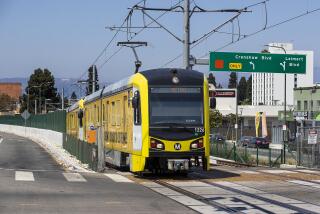June commute times have ups and downs
- Share via
Now that it’s July, it’s possible to better assess whether motorists are seeing zippier commutes on Southland freeways. The Freeway Performance Measurement System -- run by UC Berkeley and Caltrans -- has its numbers online and they are somewhat of a mixed bag.
The big winners appear to be in Riverside and San Bernardino counties, where commute times have improved or stayed the same. Any or all may explain what’s happening -- home foreclosures, high gas prices, higher unemployment, longer commutes.
For example, the average weekday commute time from Riverside to Ontario at 8 a.m. was 35.9 minutes in June compared with 40.7 minutes the previous year. The 210 Freeway in the morning from Interstate 15 to the 134 Freeway also showed a big drop, to 52.5 minutes, from 60.2 a year ago.
In Orange County, there wasn’t much change in the morning commutes, but afternoon commutes improved, with one big exception -- the eastbound 91 Freeway was substantially worse. The afternoon commute over an 8-mile stretch heading out of O.C. was 29 minutes in June and 24.9 last year. That might be caused by motorists shifting from the toll lanes to the free lanes to save money during the gas crunch.
In Los Angeles and Ventura counties, the morning commutes between Simi Valley and L.A. and Thousand Oaks and L.A. both were several minutes shorter. Westsiders may note that travel times between L.A. and Santa Monica in both directions got worse in the morning, but slightly better in the afternoon.
Sales tax hike
I spoke to state Senate Majority Leader Gloria Romero (D-Los Angeles) on Tuesday about the effort to put a half-cent sales tax increase on the November ballot in Los Angeles County to pay for road and mass transit projects.
The gist of it: A sales tax requires the passage first of a state bill, AB 2321, and as of Tuesday, Romero says she wouldn’t vote for it.
The bill is working its way through the state Senate, and if enough colleagues join her, the bill could die there -- meaning no sales tax hike on the ballot. “At this point, this bill is not in a satisfactory format for me to be able to deliver an aye vote,” Romero said. “I think we can get there, but we intend to raise these issues.”
Romero was one of many legislators from the San Gabriel Valley who met Tuesday in Sacramento for a two-hour breakfast. The “issues” she’s talking about mostly pertain to a proposed extension of the Gold Line light rail from Pasadena east through the valley.
A few highlights from my interview:
Romero does not believe the $328 million set aside for the Gold Line is sufficient. “We’d like to see it extended at least to the county line in Claremont,” Romero said. “I would say that for starters. This is a project that’s ready to go. We don’t see a need for us to wait to have more expensive projects in concept mandated in the state law” to be given a priority.
She said she’s leery that language in the bill would instead send money to a subway extension -- and that dollars for the Gold Line wouldn’t be allocated until later, if the sales tax passes muster with voters. “We definitely don’t want to be shortchanged so that we have a token extension [of the Gold Line] for a few million dollars here in order to build a massive subway to the sea that might cost $3 billion plus,” Romero said. “If the Gold Line is ready to go, let’s build it. Why should we stand in the back of the line?”
The San Gabriel Valley should not have to support the congestion pricing proposal -- and the $213 million in federal funding that it brings -- to get money from the sales tax, Romero said. And that was a message she and other elected officials delivered to Mayor Antonio Villaraigosa at their meeting Friday at City Hall, she said. “We clearly articulated we didn’t want the co-joining of the congestion pricing. These are separate issues,” Romero said.
As for congestion pricing, she said that forcing tolls on San Gabriel Valley motorists wasn’t fair because they had been, in her view, shortchanged on mass transit over the years. “I don’t think the MTA has been the most stellar representative for folks who live east of the Los Angeles River,” she said.
Finally, I asked her about the subway extension -- with so many jobs on the Westside, wouldn’t it benefit everyone in the region, including residents of the San Gabriel Valley? “I’m open to it, absolutely,” Romero said. “It’s not necessarily an either-or.”
AB 2321 has received initial approval from the Assembly and two Senate committees. It looks like it will be heard July 14 in the appropriations panel.
--
Steve Hymon writes The Times’ blog about Southern California traffic and transportation in real time. Check it out at latimes.com/bottleneck.
More to Read
Sign up for Essential California
The most important California stories and recommendations in your inbox every morning.
You may occasionally receive promotional content from the Los Angeles Times.










